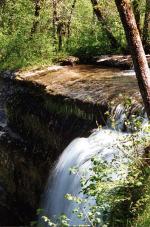|
Mackenstein Compact-Camera |
Manufactured or assembled in France from 1895 to 1895.
Index of rarity in France: Rare (among non-specialized garage sales)
Inventory number: 7010
See the complete technical specifications
Chronology of cameras Mackenstein
Cet appareil a été présenté à la SFP lors de la séance du 3 mai 1895, avec un compte-rendu très succinct paru dans le bulletin N° 13, 2e série, Tome XI. L'Annuaire de la Photographie de 1895 est plus explicite et nous apprend que pour la stéréoscopie, l'appareil était livré avec une cloison mobile intérieure, une planchette équipée de deux objectifs jumeaux et surtout que cette planchette était muni d'un rideau permettant de centrer un des objectifs afin de faire une photo plein plaque. (Toutes ses complications, jointes à un fini exemplaire et destiné à une clientèle bourgeoise, indique une fabrication par Mackenstein lui-même, contrairement aux chambres Touristes fabriquées en province et diffusées par de nombreux revendeurs.)
Ce genre de chambre à coffret va avoir une très nombreuse descendance, en général au format 9 x 12, avec les foldings.
La disposition horizontale est mise à profit pour proposer la stéréoscopie. On pouvait obtenir deux vues 9 x 12 sur la plaque 13 x 18, mais avec des intermédiaires, il devait bien sûr être possible de faire des formats plus conventionnels...
La mise au point est automatique, au sens où on peut faire le réglage en se fiant aux repères gravés sur l'abattant et indiquant les distances. L'utilisateur pouvait faire adapter des objectifs de focales différentes, mais comme l'échelle de mise au point est unique, on ne peut pas vraiment parler d'interchangeabilité.
Il est signalé aussi la possibilité d'utiliser un châssis pour rouleau de pellicule, et la bobine devait être impressionnante par sa taille !

Hermann Joseph Hubert Mackenstein was born on December 17, 1846 in Doveren, Westphalia. Orphaned at 13, he was taken in by his uncle and godfather, who has the same first names as him. He has an older sister Sophie and two brothers, Heinrich (1849-1875) and Franz (1854-1926)
From 1861 to 1866, he apprenticed with a carpenter and master apprentice near Dusseldorf. He left for companionship first in Aachen, then in Paris, but had to return to Prussia at the end of 1868 to be incorporated as a bugler in the 87th regiment in Mainz.
France having declared war on Prussia on July 19, 1870, Hermann will do the whole campaign, Wissembourg, Woerth, Phalsbourg, Sedan and the siege of Paris, from September 22, 1870 to January 27, 1871.
In early 1872, Hermann opened a carpentry workshop in Paris, 16, rue Cuvier, where he employed his brother Heinrich and two French workers. In 1875, he married Irhama Augusta Fontaine d'Ocq, with Henri Daniel Ruhmkorff as his witness (whose studio was taken over by Jules Carpentier). That same year, his brother Heinrich died at the age of 26. Around 1878, he subcontracted photographic cabinetmaking for various manufacturers, and went on to develop his own range of cameras, even exporting to England and Russia.
Member of the Société Française de Photographie in 1883, he lived at 15, rue des Carmes, with his studio nearby, impasse des boeufs. In 1897, he launched a photographic magazine, "Arc en Ciel", which ceased in 1915.
 In 1902, the Établissements Mackenstein S.A. were created, as well as a sales store at 7, avenue de l'Opéra. That same year, the range of binoculars was redesigned and the names Francia and La Francia appeared.
In 1902, the Établissements Mackenstein S.A. were created, as well as a sales store at 7, avenue de l'Opéra. That same year, the range of binoculars was redesigned and the names Francia and La Francia appeared.
On August 21, 1914, the Board of Directors notes that following the state of war, and given the name of the company, the director dismissed the staff and closed the store and the workshop. It should be noted that at this time, the staff was made up of a dozen people, that certain customers, Jougla, Girard & Boitte requested specific constructions, and that on the other hand, Mackenstein imported camera boxes from Wünsche. On January 2, 1915, the property of Hermann Mackenstein, who nevertheless had French nationality, was sequestrated, and he and his family were expelled from France in May 1916. On November 7, 1916, the director, Mr. Cousin re -opens the store, every day from 2 a.m. to 6 a.m. with the help of Mr. Léon Molitor (An indemnity of 2 F per day is allocated to the seller.)
In September 1918, the turnover was 9,977.30 F and in October, 12,171.40 F, which gives an idea of the size of the stocks.
In February 1919, production resumed with new 9 x 12 folding cameras. In July, the salaries of the director and the foreman started at 800 F monthly. Marie Mackenstein, his daughter, returned to Paris in November 1919, but Hermann could not return until 1922. He died on March 24, 1924 at the age of 78.
In 1923, the company became Etablissements FRANCIA and Hermann sold the business to his foreman and his salesperson, Suffize and Molitor, who would continue to manufacture Mackenstein cameras.
Thanks to authors and contributors
(From "Dossiers Collector N ° 13" by Jean-Loup Princelle, based on the text by Frank Körfer published in the review of Club Daguerre and the book of the Board of Directors of SA Mackenstein (1903-1923) loaned by a descendant of Henri Suffize)
Interesting links or bibliography :
Add a link or element of bibliography, a picture taken with this camera, a picture of box or an ads about this camera
Your photos taken with the same camera:
Cameras from Ebay France (Mackenstein) (Uploaded each 3 hours)








